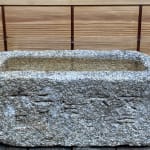




artisan's name unknown
Basin (Tsukubai), Circa 1700's (Mid Edo Period), Contact for Price
Stone
13 1/2" x 24" x 9 1/2"
Further images
The exact history of basins in Japan is not clear. The oldest extant basin is found in the Joruri-ji temple in Kyoto, with an engraving from 1269. However, the tradition...
The exact history of basins in Japan is not clear. The oldest extant basin is found in the Joruri-ji temple in Kyoto, with an engraving from 1269. However, the tradition of cleaning one’s hands in a basin before entering a temple has existed for much longer.
In the beginning of their creation, basins were carved exclusively for temples and shrines. Over time, their structure was adopted into the secular world, coinciding with the adoption of stone lanterns into lay gardens. As the Way of Tea spread in the Edo Period (1603-1868), their was a surge for demand for basins as they quickly developed into an integral facet of tea events.
In the beginning of their creation, basins were carved exclusively for temples and shrines. Over time, their structure was adopted into the secular world, coinciding with the adoption of stone lanterns into lay gardens. As the Way of Tea spread in the Edo Period (1603-1868), their was a surge for demand for basins as they quickly developed into an integral facet of tea events.
Signup for our Newsletter
You will receive two emails a month from us. One introduces artworks and design works from Kyoto's hidden sources and the other is stories from Misako, sharing insights into Japanese culture.
* denotes required fields
为了回应您的查询,我们将根据我们的隐私政策处理您提供的个人数据。




